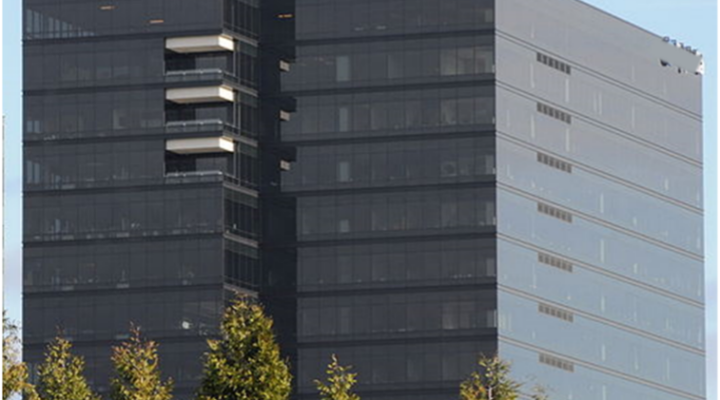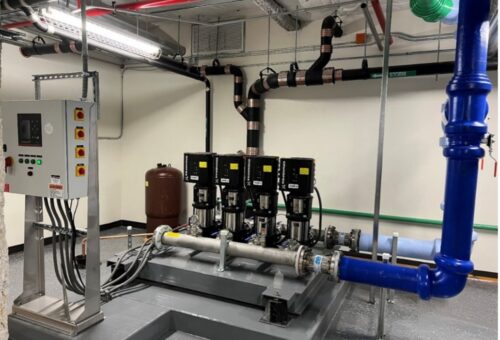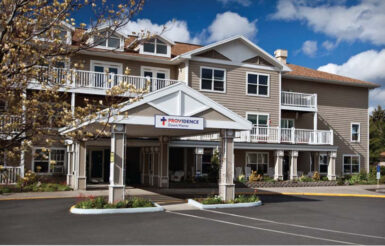Project Overview
Built in 2008, Tower 333 is a 20-story office tower in Bellevue, Wash., featuring more than 400,000 sq. ft. of rentable space. LEED- and ENERGY STAR®-certified, this Class-A office building also
Due to its height, Tower 333 requires a domestic water-booster system to deliver reliable water pressure all the way to the top floor. The original system consisted of three 20-horsepower constant-speed booster pumps that operated in a staged sequence, bringing on successive pumps as demand changed.
When Urban Renaissance Group recently purchased the building, the aging and inefficient water-booster system needed to be replaced. With a commitment to occupant comfort and maintaining the building’s energy-efficiency certifications, the company knew they had to find a replacement for the building’s aging waterbooster system that would save energy and improve performance.
Noisy and oversized constant-speed pumps.
Urban Renaissance Group’s chief facilities engineer, Kidron Cobb, encountered a variety of issues caused by the original booster pumps, including:
- Noise: The basement-located pumps were so loud, they continually interrupted occupants of the conference room above.
- Waste: The flow of water was controlled by throttling valves, a common but wasteful control strategy in which the pumps always operate at full speed, rather than operating in proportion to demand.
- Maintenance demands: Due to their size and constant speed, the system created a pressure surge—also known as a water hammer—throughout the facility’s piping whenever a pump was shut down. This water hammer effect caused frequent maintenance demands to replace the failed system components and rebuild the pumps.
Smart pumps reduce noise, waste, and maintenance needs.
After doing some research and consulting with Hurley Engineering, Cobb found his answer: a Grundfos HYDRO MPC-E smart-pump booster skid. Featuring four 5-horsepower Grundfos CRE pumps, the new skid is powered by highly efficient electronically commutated motors (ECMs). These variable-speed ECMs readily allow the system to meet fluctuating demand and, as a result, save energy.
The new smart-pump booster skid includes integrated sensors and smart controls that are performance-mapped to the specific operating characteristics of the pumps. The smart controls constantly analyze demand to determine when the pumps should turn on, and at what speed. The booster pumps no longer slam on and off, which eliminates noisy disturbances and prevents damage to plumbing components. And since smart pumps don’t use throttling valves, this solution also saves energy improves system reliability, and reduces unnecessary pressure in the system.
Energy savings and beyond.
The previous booster pumps used more than 94,000 kWh of electricity each year. Based on average occupancy, the new smart-pump booster skid is expected to achieve pump-energy savings of 82,000 kWh per year, which yields enormous energybill savings of 87%. In fact, Urban Renaissance Group expects to save more than $63,000 on energy bills over the next 10 years, all while improving the occupant experience.
The company also expects to save money on reduced maintenance needs. The original booster pumps had to be rebuilt every few years to replace prematurely worn-out seals due to the water hammer effect resulting in damages to system components. In contrast, the new pumps are expected to last at least 10 years before requiring maintenance.
Aside from the reduced energy consumption and lower maintenance concerns, Cobb noted that the installation also provided an unforeseen benefit. “By downsizing to the new booster pump skid, I am now able to run it off emergency power,” he said. “I’m confident that in the event of a power failure, we’ll still have sufficient water pressure serving the top floors.”

High energy ratings translates to savings.
The highly efficient smart pumps have an Energy Rating of 60, meaning that they use 60% less energy than a code-minimum constant speed pump. These energy savings include the pump’s hydraulic efficiency, adjustable speed drive, and advanced controls which reduce energy use throughout the pump’s operating conditions.
For more information about the Energy Rating program and label, visit the Hydraulic Institute at pumps.org/resources/energy-efficiency.
An incentivized upgrade saves even more.
To offset nearly 30% of the project cost, Hurley Engineering helped Urban Renaissance Group take advantage of valuable incentives offered by Puget Sound Energy. “Supporting the Tower 333 team on this project was rewarding considering a harmony was found to improve building functionality while effectively improving system efficiency. The reduction in electricity usage, an energy savings, should bring benefits for many years to come. Urban Renaissance Group took advantage of one of PSE’s financial incentives geared toward assisting PSE customers’ with energy efficiency projects.” said Jenny Voss, the energy management engineer who worked on the project on behalf of Puget Sound Energy.


